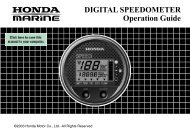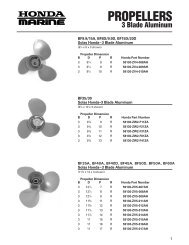You also want an ePaper? Increase the reach of your titles
YUMPU automatically turns print PDFs into web optimized ePapers that Google loves.
tains corrosive sulfuric acid.<br />
Contact with eyes or skin caus-<br />
es burns.<br />
Wear protective clothing and<br />
use eye protection when<br />
working near the battery.<br />
POISON - KEEP OUT OF REACH<br />
OF CHILDREN<br />
CARRYING<br />
NEGATIVE (-)<br />
~013 BATTERY<br />
TERMINAL<br />
POSITIVE (+) BATTERY CABLE (red)<br />
EMERGENCY PROCEDURES:<br />
Eyes<br />
Flush with water from a cup or oth-<br />
er container for at least 15 minutes.<br />
Call a physician immediately.<br />
Skin<br />
Remove contaminated clothing.<br />
Flush skin with large quantities of<br />
water. Call a physician.<br />
If swallowed<br />
Drink water or milk and call your<br />
local poison control center or physi-<br />
cian immediately.<br />
10. MAINTENANCE<br />
Battery cleaning<br />
B Batteries pioduce<br />
explosive hydrogen gas. A spark<br />
or flame can explode the battery<br />
causing serious Injury or blind-<br />
ness. Provide adequate ventila-<br />
tion.<br />
Keep sparks and flames away.<br />
Follow the procedure below<br />
carefully.<br />
Removal:<br />
1. Disconnect the negative ( - ) battery<br />
cable first, then disconnect the posi-<br />
tive (+) battery cable.<br />
2. Remove the battery from the boat.<br />
Clean the battery terminals with a<br />
wire brush or sand paper. Clean the<br />
battery with a solution of baking soda<br />
and warm water, taking care not to<br />
get the solution of water in the<br />
battery cells. Dry the battery thor-<br />
oughly.<br />
3. Clean the battery cable ends with a<br />
wire brush or sand paper.<br />
85





